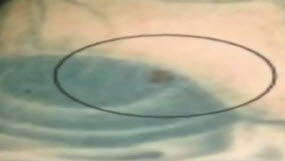 Personally, I have never had a strong desire to get a tattoo. But I do admire the variety of skin artistry that I have seen inked on some people. By some estimates, about 25% of all Americans between the ages of 18 to 50 have at least one tattoo. No longer is this art form limited to sailors and bikers.
Personally, I have never had a strong desire to get a tattoo. But I do admire the variety of skin artistry that I have seen inked on some people. By some estimates, about 25% of all Americans between the ages of 18 to 50 have at least one tattoo. No longer is this art form limited to sailors and bikers.
However, people with extensive tattooing may be hiding a potentially life-threatening problem. I’m referring to skin cancer, specifically melanoma.
Melanoma is the deadliest form of skin cancer. Over 75,000 American citizens are diagnosed with this disease each year and at least 9,000 people die from it. The melanoma may start on the skin’s upper layer, but then spread deeper beneath the dermis. When the cancer goes deeper, it can reach other body parts including your organs.
The reason most people die from it is because it’s detected too late. This is where tattoos can be a problem.
You see, the earliest indication of melanoma is usually the occurrence of a new mole or a change in an existing one. The mole could have taken on a different shape, changed color, become uneven, or enlarged.
However, when you have tattooing that covers moles and large areas of the skin, it can be very difficult for you to spot changes to your skin. Between the ink color and complexity of the tattoo design, even a dermatologist could find it difficult to evaluate your skin for unusual moles or cancer.
Of course, laser removal therapy can be used to break up the ink in the tattoo. However, the same process can be problematic when you have moles. That’s because the laser can also break up the mole. Once that happens, it’s tough to determine if and exactly how the mole has changed.
So, according to a report in the Journal of the American Medical Association (JAMA) – Dermatology, there are two key things you should do if you have tattoos already or if you’re thinking of getting one.
1. Before you get one, have a dermatologist or physician evaluate the skin area to be tattooed for any unusual moles, skin tags, or patches.
2. If you have tattoos and are thinking of getting them removed, ask the dermatologist to check the area for moles or other unusual skin conditions that may be cancerous.
In conclusion, there’s nothing wrong with getting a colorful or cool tattoo. But just like when it comes to painting the walls in your home, you should make sure that your skin’s surface is properly prepped before it’s worked on.
If you have an unusual mole or plan on getting tattoos soon, please schedule an examination at our Coral Springs dermatology office. Let us take a look.


